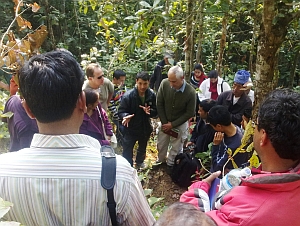Growing Carbon Money: Community Forestry and REDD+

 This blog posting was submitted by Gernot Brodnig, Senior Social Development Specialist at the World Bank.
This blog posting was submitted by Gernot Brodnig, Senior Social Development Specialist at the World Bank.
Dolakha is a heavily forested district in northern Nepal, close to the border with Tibet. Community forestry has been implemented there since the early 1980s, and more recently its Charnawati watershed became home for a REDD+ pilot project, the Forest Carbon Trust Fund (FCTF). A couple of years ago, some 58 Community Forestry User Groups (CFUGs) and their members earned their first revenues – almost US$50,000 – from “carbon forestry.” This was the first time carbon money was paid in Nepal.
The FCTF and other pilot projects across the tropics aim to demonstrate that REDD+ can build on the achievements of participatory forest management, and contribute to the livelihoods of often poor and marginalized forest communities in a sustainable manner.

Forest users’ group members learn how to measure carbon sequestration in Nepal. Credit: Nabaraj Dahal/IPS
The inclusion of communities in the management of public forest resources has become increasingly common in the last 30 years. Community forestry approaches vary a lot, both between countries and sites, and the differences often evolve around institutional dimensions such as benefit- and power-sharing arrangements. There is an increasing understanding of the multiple benefits of community empowerment in the forest sector, as well as of the limitations and constraints associated with it. A recent survey by the Rights and Resources Initiative suggests that the forest area under community tenure or management has gradually increased over the last 10 years and is now above 15% or 511 million hectares of the global forest estate (Figure 1.).


Source: Rights and Resources Initiative, 2014
The emergence of REDD+ has added emphasis and momentum to the participatory forestry discourse, and the integration of local communities is seen as a critical ingredient of equitable REDD+ architecture. There is, however, still a very limited evidence base on whether some of the conditions that underpin successful community forestry regimes will also apply to REDD+ schemes, both at the project and national level. While many elements such as the role of collective action through user groups will transfer to carbon forestry, others entail significant differences such as price volatility or separate rights to carbon.
A recent PROFOR research report aims to shed some light on these questions reviewing the interface of REDD+ pilots and community forestry in Bolivia, Nepal, and Tanzania. Drawing heavily on data from the IFRI network, its analysis points to the potential for accomplishing REDD+ objectives in community forest management (CFM) sites. REDD+ can benefit from the established successes of CFM in one or more ways:


First, REDD+ can make use of the natural, human, social, and institutional capital associated with existing community forest sites to achieve REDD+ goals. REDD+ funding can help to overcome the historical financial barrier to effective community forest management, by increasing the capacity for management activities such as rule-enforcement. Second, REDD+ funding can also be used to expand the area of forests managed by communities. But in both cases, existing practices do not present solutions to all REDD+ implementation challenges. Pilot projects and readiness activities are therefore also augmenting existing community forest capacity by investing in the development of new institutions, benefit-distribution mechanisms, and mechanisms to monitor, report, and verify carbon objectives.








